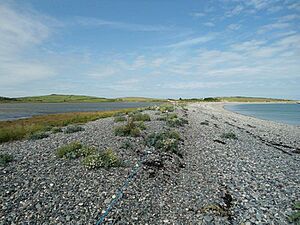Cemlyn Bay and lagoon facts for kids
Cemlyn Bay is a beautiful bay on the northwest coast of Anglesey, in North Wales. It's about 2.5 kilometers west of the Wylfa nuclear power station, within the area called Cylch-y-Garn.
A long shingle beach separates the bay from a special salty lake called a lagoon. Small streams feed this lagoon. A small dam, called a weir, at one end of the beach helps control the lagoon's water level.
This area is very important for nature. It was named a Site of Special Scientific Interest (SSSI) in 1957. Cemlyn Bay is also part of the Anglesey Heritage Coast and the Isle of Anglesey Area of Outstanding Natural Beauty. The National Trust owns the land here. The lagoon and its surroundings are part of the Cemlyn Nature Reserve. This reserve was set up in 1971 and is managed by the North Wales Wildlife Trust. The Anglesey Coastal Path, a popular walking route, also passes through Cemlyn Bay.
Contents
Amazing Birds at Cemlyn Bay
Cemlyn Bay is famous for its many birds. It's especially known for its large colony of terns. Terns are seabirds that look a bit like gulls but are more graceful.
Tern Colony: A Special Home
On small islands in the lagoon, there's a very important tern colony. It's the only place in Wales where Sandwich terns breed. In recent years, about 1,500 pairs of Sandwich terns have nested here. This makes Cemlyn the third-largest colony in the United Kingdom!
Arctic terns and common terns also breed here regularly. Roseate terns visit occasionally. Because of these important birds, Cemlyn is part of a larger protected area. This area is called the Ynys Feurig, Cemlyn Bay and The Skerries Special Protection Area. It includes two other nearby places: Ynys Feurig and The Skerries. All three sites are also recognized as an Important Bird Area by BirdLife International. The terns often fly between these three places. They are part of a bigger group of terns living around the Irish Sea, including birds from places like Rockabill Island in Ireland. To protect the terns, wardens look after the colony from May to August.
Other Birds You Might See
Many other birds also breed at Cemlyn. These include black-headed gulls, ringed plovers, oystercatchers, and shelducks. In winter, the site is important for water birds like wigeon, shoveler, and teal.
Rare Visitors: Vagrant Birds
Cemlyn Bay has also attracted some very rare birds. These are called vagrant birds because they have wandered far from their usual homes. Birdwatchers, also known as twitchers, love to visit Cemlyn for this reason.
For example, a bridled tern stayed here for several weeks in July 1988. A sooty tern, another rare visitor to Britain, was seen on and off in July 2005. At those times, very few birdwatchers in Britain had ever seen these species. More recently, a squacco heron was spotted in June 2015.
Other Interesting Nature
The shingle beach at Cemlyn is home to special plants that can grow near the sea. You might find plants like sea kale, sea beet, sea campion, thrift, and yellow horned poppy.
Around the edges of the lagoon, there are plants that like salty conditions. These include sea aster, sea purslane, Danish scurvygrass, and different types of saltmarsh oraches. You can also find grey mullet fish living in the lagoon.
Gallery
-
Tern colony in lagoon
-
Twitcher admiring sooty tern
-
Sooty and Sandwich terns in colony
-
A spotted redshank on the edge of the lagoon
Images for kids








